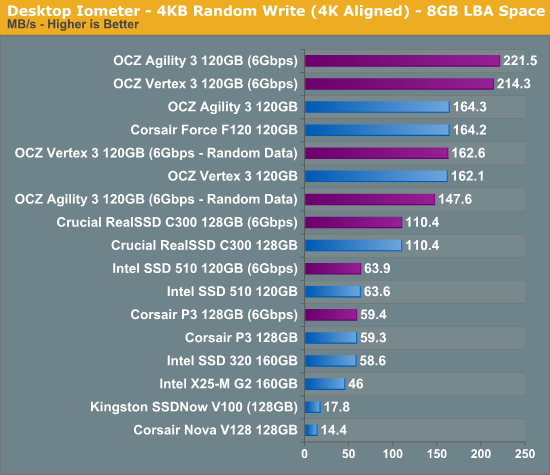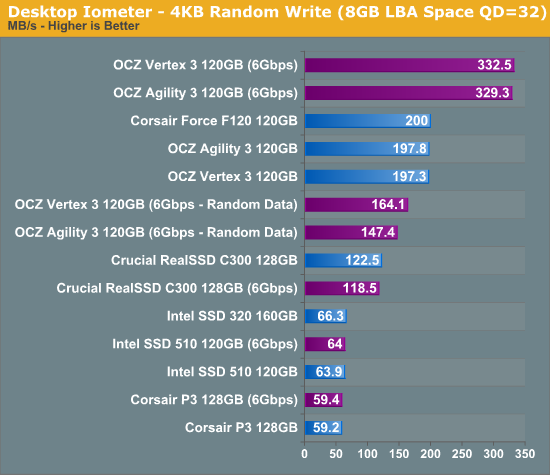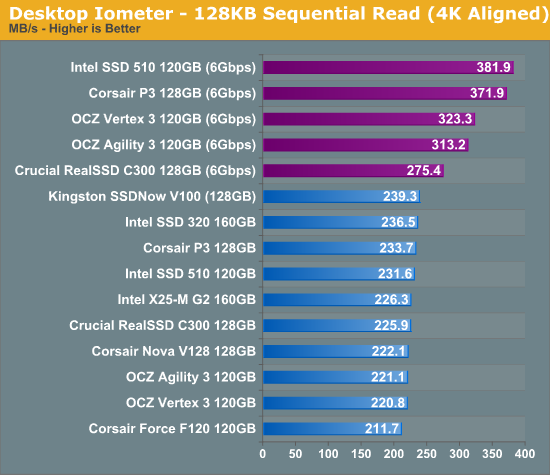The 2011 Mid-Range SSD Roundup: 120GB Agility 3, Intel 510 and More Compared
by Anand Lal Shimpi on June 7, 2011 12:52 PM ESTRandom Read/Write Speed
The four corners of SSD performance are as follows: random read, random write, sequential read and sequential write speed. Random accesses are generally small in size, while sequential accesses tend to be larger and thus we have the four Iometer tests we use in all of our reviews.
Our first test writes 4KB in a completely random pattern over an 8GB space of the drive to simulate the sort of random access that you'd see on an OS drive (even this is more stressful than a normal desktop user would see). I perform three concurrent IOs and run the test for 3 minutes. The results reported are in average MB/s over the entire time. We use both standard pseudo randomly generated data for each write as well as fully random data to show you both the maximum and minimum performance offered by SandForce based drives in these tests. The average performance of SF drives will likely be somewhere in between the two values for each drive you see in the graphs. For an understanding of why this matters, read our original SandForce article.

At worst, SandForce's small file random write performance is equal to its closest competitors, but at best it is significantly greater. Both the Vertex 3 and Agility 3 take the cake here. The Marvell based solutions are significantly slower, however we'll see if that matters in the real world tests.
Many of you have asked for random write performance at higher queue depths. What I have below is our 4KB random write test performed at a queue depth of 32 instead of 3. While the vast majority of desktop usage models experience queue depths of 0 - 5, higher depths are possible in heavy I/O (and multi-user) workloads:

At higher queue depths the advantage just grows for the SF-2281 drives.

Crucial optimized very heavily for random read performance, and to this day nothing (even the replacement m4/C400) can outperform the C300 in our small file random read test. Intel's SSD 510 is the next fastest 6Gbps drive we've got here, followed by the P3 and eventually the Vertex 3/Agility 3.
Sequential Read/Write Speed
To measure sequential performance I ran a 1 minute long 128KB sequential test over the entire span of the drive at a queue depth of 1. The results reported are in average MB/s over the entire test length.

To post high sequential read speeds you need to have a 6Gbps interface these days. Armed with one the Intel SSD 510 and Corsair P3 both post the highest scores here. Even the Vertex 3/Agility 3 are a bit behind the two Marvell drives.

Sequential write performance is another story entirely. With highly compressible data the Vertex 3 is untouched and even in the worst case it's still among the fastest drives. I'll chalk this one up as a win for OCZ, however the rest of the competitors do well here.










68 Comments
View All Comments
JasonInofuentes - Tuesday, June 7, 2011 - link
"It's funny how little the recommendations have changed over the years. Intel still offers a good balance of performance and reliability, however if you're willing to take a risk on the reliability front you can get better value elsewhere."http://www.anandtech.com/show/2738
scook9 - Tuesday, June 7, 2011 - link
Looks good. I recently got a 160GB Intel 320 drive for my M18x but since it has Sata 6Gbps I am going to be pretty tempted to trade up to a 510 down the road. Just could not get excited over that $$/GB for nowStargrazer - Tuesday, June 7, 2011 - link
Awesome. Thanks.(first (non-french) comparison of current-gen ~128GB SSDs I've seen)
apexjr - Tuesday, June 7, 2011 - link
Anand,Thank you for this! This is exactly what I have been waiting for.
dhanson8652 - Tuesday, June 7, 2011 - link
The chart labels on page 5 are conflicting with both charts being labeled read/write write/read with the inverse white on orange text being correct and the black on orange text being incorrect.Anand Lal Shimpi - Tuesday, June 7, 2011 - link
Fixed :)Oxford Guy - Thursday, June 9, 2011 - link
240 GB Vertex 2 at some point... prettie please?You talk about the 240 GB drives offering best case performance. Don't you think people would like to know how good the performance of the 240 GB Vertex 2 is in comparison with 120 GB next-gen units like these?
apexjr - Tuesday, June 7, 2011 - link
For me this article gives weight to the research I have done and the hours reading and analyzing other reviews.For the laptop I had chose the Intel 510 because it has the least power draw idle, 6 Gbps and a proven track record of reliability.
For my gaming machine I had chose the Vertex 3 240gb. Even with the reliability issues that might happen I have nightly backups running (Easy to setup with Windows 7) and spare drives to swap in should something happen.
Confusador - Tuesday, June 7, 2011 - link
One of the things that's held me back from getting an SSD is that I always have at least 2 OSes installed, and a common data partition. Can anyone point me at info on how these drives handle that? I can't find anywhere that Anand has covered it in his roundups. I'd like to know how it affects performance, but what I'm really concerned about is drive life, if the partitioning interferes with the controller's ability to optimize wear leveling.cgeorgescu - Tuesday, June 7, 2011 - link
It's amazing how a Corsair Force F120 (or some Vertex2) still manages to not be beaten that hard by these new arrivals. In pure benchmarks, the new drives have some impressive results but, as long as we're speaking about real-life scenarios, F120 suddenly appears in the graph not far under the new drives.